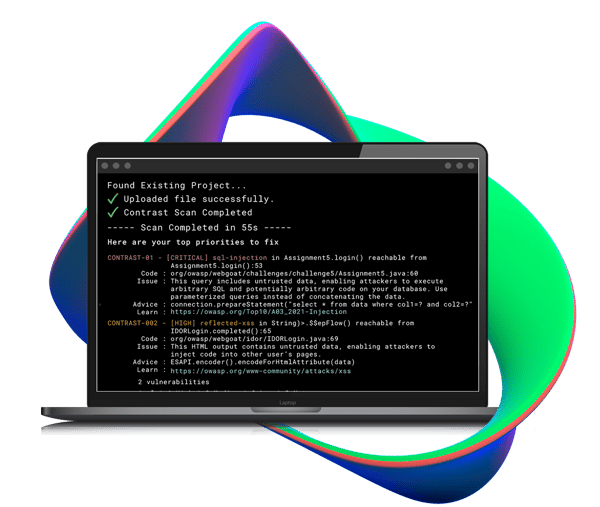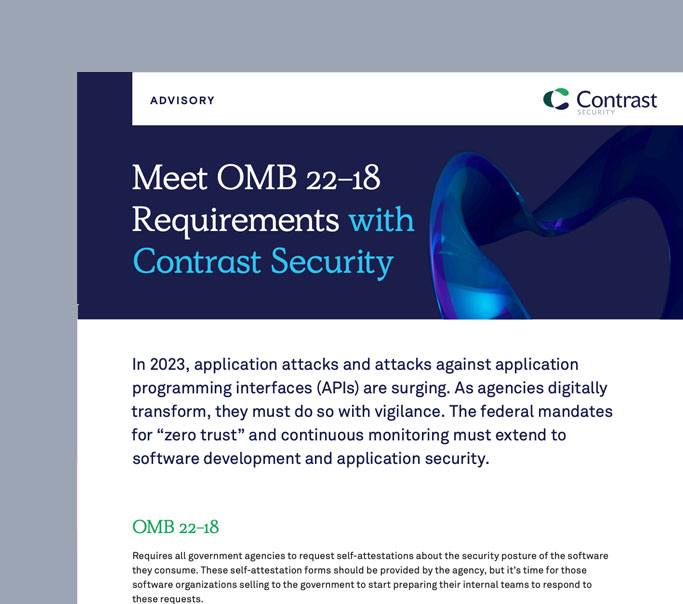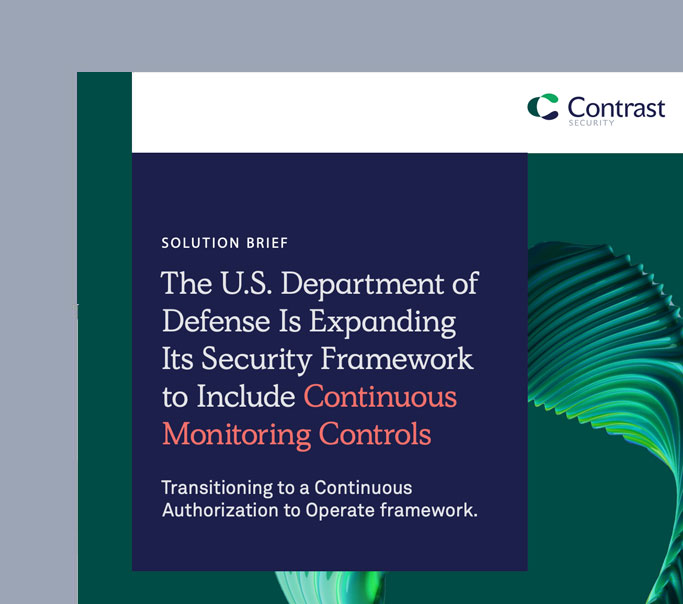Welcome to the New Era of Software Accountability
Achieve complete SDLC security transparency.

Protect Your Entire Software Development Lifecycle
_10252021-1.png?width=500&height=329&name=Blog_SECURING-THE-SOFTWARE-SUPPLY-CHAIN-STARTS-WITH-A-SOFTWARE-BILL-OF-MATERIALS-(SBOM)_10252021-1.png)
Maintain Up-To-Date SBOMs Across All of your Applications and APIs
Contrast creates a comprehensive software bill of materials (SBOMs) to meet regulatory and procurement requirements with support for both CycloneDX and SPDX. Contrast goes above and beyond the minimum SBOM standards set by NIST detailing critical security, versioning, environmental, and library usage information in its bill of materials.
Biden Administration’s New Announcement - Shifting Liability for Software Products to Vendors
The National Cybersecurity Strategy will have a major impact on businesses. Organizations will be required to meet minimum security requirements and adhere to secure principles to protect their data and systems from malicious threats. Vendors must now be responsible for the security of their technologies, and organizations handling individual data must pay closer attention to how they protect that data.


OMB 22-18 Now Mandates Zero-Trust and Continuous Monitoring
Federal Mandate OMB 22-18 requires all government agencies to request self-attestations about the security posture of the software they consume. These self-attestation forms should be provided by the agency, but it’s time for those software organizations selling to the government to start preparing their internal teams to respond to these requests.
CISA Launches New Pilot Program for Ransomware Protection
CISA announced a Ransomware Vulnerability Warning Pilot (RVWP) program to identify vulnerabilities in critical infrastructure systems that ransomware groups exploit. This initiative aims for timely risk reduction by alerting infrastructure owners and operators about vulnerabilities in their systems.
The pilot program requires CISA to develop regulations for covered entities to report cyber incidents and ransomware payments. With ransomware posing a significant threat to national security and public safety, the RVWP aims to provide actionable information to reduce damaging ransomware incidents.


Health and Human Services Transitions to NIST Cybersecurity Framework
The Department of Health and Human Services now adopts and aligns with the NIST Cybersecurity Framework. This transition will require all government agencies and vendors to adhere to the minimum requirements of NIST for all their Cybersecurity requirements
The Cybersecurity Framework Implementation Guide provides specific steps that health care organizations must take immediately to manage cyber risks to their information technology systems and reduce the number of cyber incidents affecting the sector. The plan will make sure that health organizations can better protect their patients, intellectual property, and research.
Align with Government Regulations
Comply With Audit and Compliance Workflows
With centralized visibility across all environments and continuous threat monitoring, you'll be fully prepared for audits and reporting.
Achieve Secure Code Flow
The Contrast Secure Code Platform makes security invisible to the developer by turning every test into a security test.
Simple Unified Platform
From development to production, the only unified platform to protect your complete software development lifecycle.

Optimized Security to Protect Your Software
-
Continuously monitor applications for vulnerabilities
-
Protect from zero-day
attacks -
Discover open-source and
API risks
The Contrast Secure Code Platform
Experience how the Contrast Secure Code Platform enables companies to maintain levels of accountability across the entire software development lifecycle (SDLC).
Stay up to date on the latest AppSec governance trends

OMB 22-18 Requirements
Datasheet
In 2023, application attacks and attacks against application programming interfaces (APIs) are surging. As agencies digitally transform, they must do so with vigilance. The federal mandates for “zero trust” and continuous monitoring must extend to software development and application security.

DEFEND FROM WITHIN
Blog
In recent years, geopolitical tension has been escalating in cyberspace, with the war in Ukraine spawning systemic cyberattacks against Western critical infrastructure. In 2023, defending from within will be paramount.

How to create SBOMs for free with CodeSec by Contrast
Blog
A recent Executive Order from the Biden Whitehouse instructs various government agencies to take action to improve our nation’s cybersecurity. One of those actions is to provide guidance and standards on Software Bills of Materials (SBOMs).

CISA Zero Trust Maturity Model
Contrast maps to the directives of the Application Security pillar (Pillar 4).

NIST 800-53, Rev. 5
Blog
Contrast employs Runtime Application Self-Protection (RASP) to address SI-17(7) and Interactive Application Security Testing (IAST) to address SA-11(9) in the latest NIST 800-53 revision.

Biden administration 2021 cybersecurity executive order
Blog
Agencies can meet requirements outlined in EO Sections 2, 3, 4 & 7 for the purposes of modernizing federal app security and software supply-chain observability.

CISA binding operational directive 22-01
Blog
Agencies can leverage Contrast to help remediate over 250 vulnerability classes mentioned in the directive while providing real-time protection as a mitigating control.

The U.S Department of Defense is Expanding its Security Framework to Include Continuous Monitoring Controls
Solution Brief
Government and federal agencies have long observed the National Institute of Standards and Technology’s (NIST’s) Risk Management Framework for security frameworks to help agencies select suitable safeguards relating to cybersecurity, privacy and supply-chain risk management.




